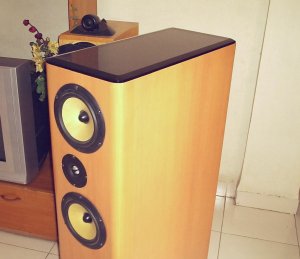(Originally written in July 2006)
The Asawari is the first pair of speakers I really designed. This includes learning how to design an enclosure, how to take all kinds of measurements, and how to design a crossover. A discussion on this project happened on this thread, in case you are interested in what some others said.
Genesis
I started dabbling with DIY audio again sometime in 2001 after a long gap, after I bought my last factory-made music system (described elsewhere) and realised that most things in the commercial domain were priced at illogical levels. I discovered the world of loony commercial audiophile publications, with their very dubious reviews, full of "harmonic rightness in the strings" and their "palpable, get-up-and-do-it texture". I also saw what the Internet had to offer the DIY audio builder, and I was convinced that sensible people with a bit of brains and a lot of patience could do much better if they went the DIY audio route.
I knew nothing about speaker design at that time, in 2001-2002, and I found all discussions of speaker design littered with frightening allusions to phase coherence, measurement microphones, the Black Art of Crossover Design, and what not. So I went looking for ready designs which I could simply build. I was not averse to building, but designed seemed beyond me.
I couldn't find any good designs which I could copy, primarily because I couldn't find any easy way to import drivers into India. So I blew up a lot of money to import just one pair of drivers, which claimed to be "full range". Those were the Jordan JX92S. They were excellent drivers of their genre, and I stuck them into bass reflex boxes, but the resultant sound didn't come anywhere close to replacing my mid-fi store-bought Wharfedale floorstanders. And I paid a huge sum as courier charges to import that small pair of 4" drivers from the UK. Luckily, there were no Customs duties; the Customs guys saw that the quantity was just two units, and simply wrote the shipment off as a sample.
That's when I realised that I had three choices:
- stick to factory-made systems, and work my ass off earning money to pay for those pieces of overpriced exotica (which are even more exotic in India than, say, in the Europe or North America)
- figure out a way to import all the drivers and other components to build pre-designed speaker designs, OR
- learn to design my own speakers and use Indian drivers
I didn't have the money or the ass to select Option 1. I couldn't find any way to easily import drivers from overseas: even friends of ten years standing who professed undying love and devotion suddenly seemed to find it very difficult to carry a small five-kilo carton of neatly-packed components with them during their trips from the Silicon Valley to India. So I had to let go of Option 2. I was left with Option 3: I'd better learn to design from scratch.
So I mounted a two-pronged offensive. I sat at the feet of Gooroo Angshoo, my friend, who has been designing his own speakers for many years, first using Calsod, then using Speaker Workshop. I tried to learn how to measure a driver's characteristics, and how to design crossovers. I coaxed friends to carry home for me a few Panasonic mic capsules, and a USB external sound card for my laptop, so I could do measurements. I started walking up the difficult uphill slope of speaker measurement and design.
The second battlefront was a market survey: I wanted to find out what was available in India. I managed to gather a comprehensive database of items, which I posted on diyaudio here on 12 Feb 2004. By that time, I'd already done a year's market surveying and visiting and buying bits and pieces of samples. This thread grew and grew, and I acquired my most valuable DIY assets: a group of loyal friends. I also appreciated how much more difficult DIY audio is in India compared to countries which have vendors like Parts Express, Digikey, Madisound and Wilmslow Audio. Internet access and forum interaction is one thing, getting access to physical objects is quite another.
In parallel with all this, I bought a few Bolton 16SJW22 6.5" poly cone midbass drivers, because Angshu had used some customised version of them in some previous projects. Unfortunately, when I measured their T/S parameters with a lot of help from Angshu, I discovered that their Qts was higher than 0.7; more in the range of 0.9. So, whatever anyone did with these drivers, there would be no way of getting a nice and flat low end with them in a sealed or bass reflex box... they would behave properly only if put into active speaker designs with their Q brought down forcibly using a Linkwitz Transform circuit. Someone else on the forums tried playing around with some other Boltons, and this is what I told him. Depressing.
I didn't want to get into active speaker design as my very first project, so I kept looking for more "normal" drivers. I found Vifa midbass units being sold by a DIY dealer in Bangalore (Corrson) but they were too expensive for my first project. I then chanced upon Peerless India drivers. They had a wholesale distributor and a few dealers here in Bombay. I was excited. I didn't know it at that time, but this was the turning point which led to the specific design I now call the Asawari.

